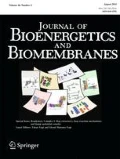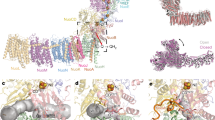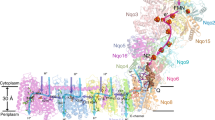Absract
NADH-ubiquinone oxidoreductase (complex I) is the first and largest enzyme in the respiratory chain of mitochondria and many bacteria. It couples the transfer of two electrons between NADH and ubiquinone to the translocation of four protons across the membrane. Complex I is an L-shaped assembly formed by the hydrophilic (peripheral) arm, containing all the redox centres performing electron transfer and the membrane arm, containing proton-translocating machinery. Mitochondrial complex I consists of 44 subunits of about 1 MDa in total, whilst the prokaryotic enzyme is simpler and generally consists of 14 conserved “core” subunits. Recently we have determined the first atomic structure of the entire complex I, using the enzyme from Thermus thermophilus (536 kDa, 16 subunits, 9 Fe-S clusters, 64 TM helices). Structure suggests a unique coupling mechanism, with redox energy of electron transfer driving proton translocation via long-range (up to ~200 Å) conformational changes. It resembles a steam engine, with coupling elements (akin to coupling rods) linking parts of this molecular machine.


Similar content being viewed by others
References
Baradaran R, Berrisford JM, Minhas GS, Sazanov LA (2013) Crystal structure of the entire respiratory complex I. Nature 494(7438):443–448
Belevich G, Knuuti J, Verkhovsky MI, Wikstrom M, Verkhovskaya M (2011) Probing the mechanistic role of the long alpha-helix in subunit L of respiratory complex I from Escherichia coli by site-directed mutagenesis. Mol Microbiol 82(5):1086–1095
Berrisford JM, Sazanov LA (2009) Structural basis for the mechanism of respiratory complex I. J Biol Chem 284(43):29773–29783
Birrell JA, Hirst J (2010) Truncation of subunit ND2 disrupts the threefold symmetry of the antiporter-like subunits in complex I from higher metazoans. FEBS Lett 584(19):4247–4252
Brandt U (2006) Energy converting NADH:quinone oxidoreductase (complex I). Annu Rev Biochem 75:69–92
Bridges HR, Bill E, Hirst J (2012) Mossbauer spectroscopy on respiratory complex I: the iron-sulfur cluster ensemble in the NADH-reduced enzyme is partially oxidized. Biochemistry 51(1):149–158
Carroll J, Fearnley IM, Skehel JM, Shannon RJ, Hirst J, Walker JE (2006) Bovine complex I is a complex of 45 different subunits. J Biol Chem 281(43):32724–32727
Chouchani ET, Methner C, Nadtochiy SM, Logan A, Pell VR, Ding S, James AM, Cocheme HM, Reinhold J, Lilley KS, Partridge L, Fearnley IM, Robinson AJ, Hartley RC, Smith RA, Krieg T, Brookes PS, Murphy MP (2013) Cardioprotection by S-nitrosation of a cysteine switch on mitochondrial complex I. Nat Med 19(6):753–759
Cooley RB, Arp DJ, Karplus PA (2010) Evolutionary origin of a secondary structure: pi-helices as cryptic but widespread insertional variations of alpha-helices that enhance protein functionality. J Mol Biol 404(2):232–246
Efremov RG, Sazanov LA (2011a) Respiratory complex I: ‘steam engine’ of the cell? Curr Opin Struct Biol 21(4):532–540
Efremov RG, Sazanov LA (2011b) Structure of the membrane domain of respiratory complex I. Nature 476(7361):414–420
Efremov, R. G. and L. A. Sazanov (2012) The coupling mechanism of respiratory complex I - A structural and evolutionary perspective. Biochimica et Biophysica Acta
Efremov RG, Baradaran R, Sazanov LA (2010) The architecture of respiratory complex I. Nature 465(7297):441–445
Euro L, Belevich G, Verkhovsky MI, Wikstrom M, Verkhovskaya M (2008) Conserved lysine residues of the membrane subunit NuoM are involved in energy conversion by the proton-pumping NADH:ubiquinone oxidoreductase (Complex I). Biochim Biophys Acta 1777:1166–1172
Friedrich T (2001) Complex I: a chimaera of a redox and conformation-driven proton pump? J Bioenerg Biomembr 33(3):169–177
Galkin AS, Grivennikova VG, Vinogradov AD (1999) H+/2e− stoichiometry in NADH-quinone reductase reactions catalyzed by bovine heart submitochondrial particles. FEBS Lett 451(2):157–161
Galkin A, Drose S, Brandt U (2006) The proton pumping stoichiometry of purified mitochondrial complex I reconstituted into proteoliposomes. Biochim Biophys Acta 1757(12):1575–1581
Galkin A, Meyer B, Wittig I, Karas M, Schagger H, Vinogradov A, Brandt U (2008) Identification of the mitochondrial ND3 subunit as a structural component involved in the active/deactive enzyme transition of respiratory complex I. J Biol Chem 283(30):20907–20913
Hayashi T, Stuchebrukhov AA (2010) Electron tunneling in respiratory complex I. Proc Natl Acad Sci U S A 107(45):19157–19162
Hinchliffe P, Carroll J, Sazanov LA (2006) Identification of a novel subunit of respiratory complex I from Thermus thermophilus. Biochemistry 45(14):4413–4420
Hirst J (2010) Towards the molecular mechanism of respiratory complex I. Biochem J 425(2):327–339
Hunte C, Zickermann V, Brandt U (2010) Functional modules and structural basis of conformational coupling in mitochondrial complex I. Science 329(5990):448–451
Kaila VR, Wikstrom M, Hummer G (2014) Electrostatics, hydration, and proton transfer dynamics in the membrane domain of respiratory complex I. Proc Natl Acad Sci U S A 111(19):6988–6993
Mathiesen C, Hagerhall C (2002) Transmembrane topology of the NuoL, M and N subunits of NADH:quinone oxidoreductase and their homologues among membrane-bound hydrogenases and bona fide antiporters. Biochim Biophys Acta 1556(2–3):121–132
Nakamaru-Ogiso E, Kao MC, Chen H, Sinha SC, Yagi T, Ohnishi T (2010) The membrane subunit NuoL (ND5) is involved in the indirect proton pumping mechanism of escherichia coli complex I. J Biol Chem 285(50):39070–39078
Page CC, Moser CC, Chen X, Dutton PL (1999) Natural engineering principles of electron tunnelling in biological oxidation-reduction. Nature 402(6757):47–52
Roessler MM, King MS, Robinson AJ, Armstrong FA, Harmer J, Hirst J (2010) Direct assignment of EPR spectra to structurally defined iron-sulfur clusters in complex I by double electron–electron resonance. Proc Natl Acad Sci U S A 107(5):1930–1935
Sazanov LA (2007) Respiratory complex I: mechanistic and structural insights provided by the crystal structure of the hydrophilic domain. Biochemistry 46(9):2275–2288
Sazanov LA, Hinchliffe P (2006) Structure of the hydrophilic domain of respiratory complex I from Thermus thermophilus. Science 311(5766):1430–1436
Screpanti E, Hunte C (2007) Discontinuous membrane helices in transport proteins and their correlation with function. J Struct Biol 159(2):261–267
Steimle S, Willistein M, Hegger P, Janoschke M, Erhardt H, Friedrich T (2012) Asp563 of the horizontal helix of subunit NuoL is involved in proton translocation by the respiratory complex I. FEBS Lett 586(6):699–704
Torres-Bacete J, Nakamaru-Ogiso E, Matsuno-Yagi A, Yagi T (2007) Characterization of the NuoM (ND4) subunit in Escherichia coli NDH-1: conserved charged residues essential for energy-coupled activities. J Biol Chem 282(51):36914–36922
Torres-Bacete J, Sinha PK, Matsuno-Yagi A, Yagi T (2011) Structural contribution of C-terminal segments of NuoL (ND5) and NuoM (ND4) subunits of complex I from escherichia coli. J Biol Chem 286(39):34007–34014
Verkhovskaya ML, Belevich N, Euro L, Wikstrom M, Verkhovsky MI (2008) Real-time electron transfer in respiratory complex I. Proc Natl Acad Sci U S A 105(10):3763–3767
Vignais PM, Billoud B, Meyer J (2001) Classification and phylogeny of hydrogenases. FEMS Microbiol Rev 25(4):455–501
Vinogradov AD (1998) Catalytic properties of the mitochondrial NADH-ubiquinone oxidoreductase (complex I) and the pseudo-reversible active/inactive enzyme transition. Biochim Biophys Acta 1364(2):169–185
Vinothkumar KR, Henderson R (2010) Structures of membrane proteins. Q Rev Biophys 43(1):65–158
Walker JE (1992) The NADH - ubiquinone oxidoreductase (complex I) of respiratory chains. Q Rev Biophys 25(3):253–324
Wikstrom M (1984) Two protons are pumped from the mitochondrial matrix per electron transferred between NADH and ubiquinone. FEBS Lett 169(2):300–304
Yagi T, Matsuno-Yagi A (2003) The proton-translocating NADH-Quinone oxidoreductase in the respiratory chain: the secret unlocked. Biochemistry 42(8):2266–2274
Author information
Authors and Affiliations
Corresponding author
Rights and permissions
About this article
Cite this article
Sazanov, L.A. The mechanism of coupling between electron transfer and proton translocation in respiratory complex I. J Bioenerg Biomembr 46, 247–253 (2014). https://doi.org/10.1007/s10863-014-9554-z
Received:
Accepted:
Published:
Issue Date:
DOI: https://doi.org/10.1007/s10863-014-9554-z




